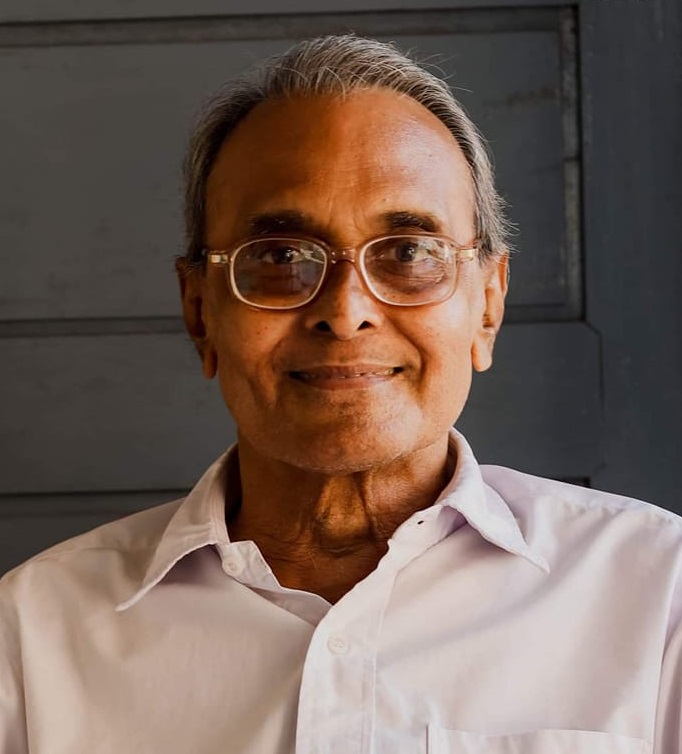The only wealth Menon amassed during his solitary journey was that of art.
When Vijayakumar Menon departed from this world with him vanished a vast treasure trove of knowledge on art, architecture, mural paintings, ecology, folklore and so on and so forth. The knowledge he amassed during his solitary journey was the only wealth he amassed during his lifetime on the earth.
Hailing from Elamakkara in Ernakulam in Kerala state, Menon had health issues from childhood which continued to haunt him till he breathed his last at the age of 76 years on Nov 1.
The isolation of the sick room opened up his mind to the awesome world of art. But, the first profession he turned to was that of a plant engineer at Fertilizers and Chemicals Travancore (FACT), Udyogamandal, in Ernakulam after his graduation in B.Sc chemistry from Sree Sankara College, Kalady.
Menon was initiated into the world of art at Kerala Kalapeetom, the iconic art institution of Ernakulam, that played a major role in formulating the cultural landscape of Ernakulam in the 70s, 80s and well the 90s.
The evenings at Kerala Kalapeetom, filled with art, cinema, theatre and literature, introduced Menon to a whole new world. He took to writing on art and received due attention from stalwarts like Ponjikkara Rafi.
Birth of an art historian
Working at FACT further aggravated his health issues, forcing him to quit the job. Later, Menon pursued the study of art history. He attended the M.S. University, Baroda, and did a post-graduation in art history at the age of 41.
Returning from Baroda, Menon worked as a teacher at Chamarajendra Academy of Visual Arts (CAVA), Mysore, for a short period. Menon returned to Kerala, seeking refuge from the polluted air of his native Ernakulam, he moved to Njanasramam, an asram located in the peaceful verdant hillside of Wadakkancherry near Thrissur. For 36 years, the asram remained his home.
I met Menon way back in 1996 during my stint as a correspondent for The Hindu’s Friday Features. It was a chance encounter. And, like many other chance encounters in my life, it diverted my path of life into totally unforeseen directions.
After meeting Menon at Chitram Art Gallery in Kochi, I asked him for an interview. He granted the nod and I met him at Government College of Fine Arts, Thrissur.
After the interview was over, Menon suggested that we should walk over to the Kerala Lalithakala Akademi, which was just down the street, and meet Prof Ajayakumar, who had recently assumed office as secretary.
Prof. Ajayakumar, who was on deputation from the post of principal at Government College of Fine Arts, Thiruvananthapuram, had been influential in bringing out Menon from his recluse at Wadakkancherry and prompting him to write, travel and talk.
Ajayakumar invited me to participate in an art journalists’ camp that the Akademi was planning to conduct.
At the camp, Menon along with a host of art history teachers and scholars introduced the nuances of art history and the theory of art. Among the participants of that camp were Dr. Sunil P. Elayidom, the celebrated scholar and orator.
Vijayakumar Menon has authored many books, including Adhunika kala darshanam, Ravi Varma,
Bharatheeya Kala Irupathaam Noottandil, Daivathay, Sthalam Kalam Kala, Chithrakala: Charithravum Reethikalum, Adhunika Kalayude Lavanyathalangal, A Brief Survey of the Art Scenario, Bharatheya kala Charithram, Bharatheeya Lavanya Vicharavum Kalaparasparyavum, Authenticating Objectivity: Paintings of Dr. A. R. Poduval, K. Madhava Menon – Prakrithi, Lavanyam, Darsanam, Kerala Kala Samskaram, Kanayi Kunhiraman and Our Traditional Leather Shadow Puppetteers – Leather Shadow Puppetteers in South India (with Babu Namboothiri K). He was the editor of two volumes, Kalamezhuthu and Puzhayude Nattarivu.
He translated plays, including Lorca’s Blood Wedding, Ionesco’s The Chairs and Jean Genet’s The Maids
Curiosity of a child
Vijayakumar Menon received many honours, including the Kerala Sahithya Akademi Award, Kerala Lalithakala Akademi Award, Kesari Puraskaram, G. N. Pillai Endowment of Kerala Sahithya Akademi for Vaijnanika Sahithyam, CJ Smaraka Prasanga Samithi Award, Dr. C P Menon Smaraka Puraskaram, and Gurudarsana Award, among others.
Though he had spent the latter part of his life in the asram, he was far from being religious. Perhaps his only religion was art. He pursued it with the excitement and curiosity of a child.
Vijayakumar Menon imparted that knowledge to everyone around him with that same excitement. He was a trailblazer in the field of art history and art criticism in Kerala.
I prefer to refer to him both as an art historian and an art critic because these two genres intermingled in Malayalam during the period when he started writing. That was a time when there was hardly any writing on art in Kerala, except for sporadic articles. It was Menon who taught Malayalis that there was a specific method to appreciate and understand art.
He was unbiased and impartial. He could find excitement in discovering art even in the drawings of a five-year-old child.
Maybe that is not exactly the quality expected of a professional art critic these days. But Vijayakumar Menon never staked claims to be professional in that sense. For him, art was a never-ending passion.
Some people are like that. They traverse through life with a mind and eyes that are always kept open. They seek out the wonders that life provides and impart those wonders to everyone around them. Even when they ultimately fade out, the wonders that they pointed out will always remain with us.

